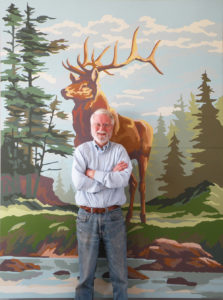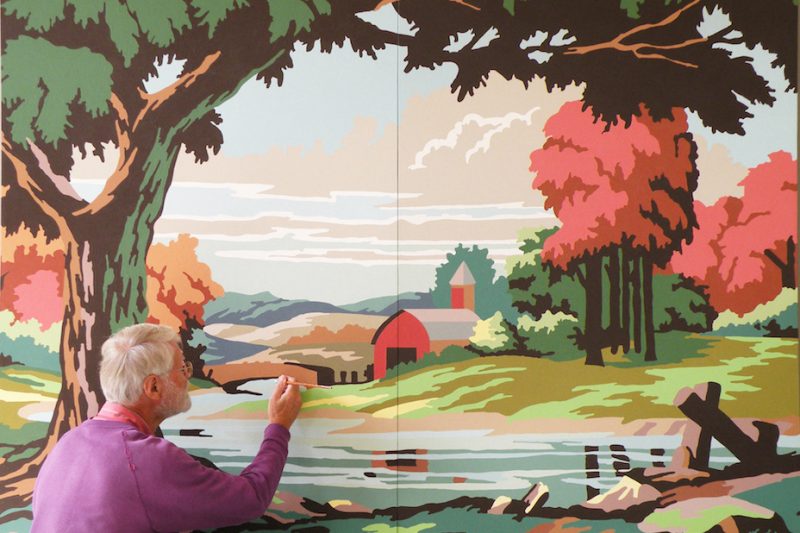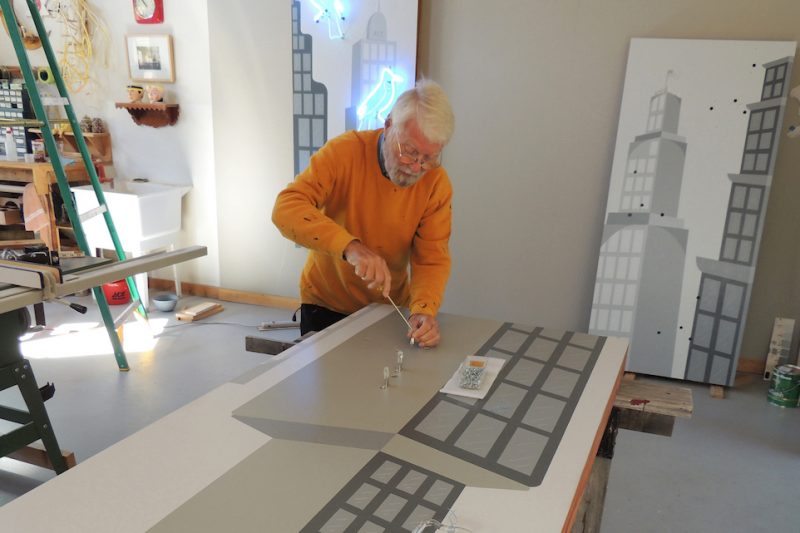Toward the end of his tenure, Gov. Steve Bullock honored four Montanans – Patty Bergquist, Arni Fishbaugh, Gordon McConnell and Willem Volkersz – and Blackfoot Pathways: Sculpture in the Wild for their impressive contributions to the arts with Governor’s Arts Awards.
Our profiles of the five recipients begin with Bozeman artist Willem Volkersz.
“Willem Volkersz’s art is human and humane,” writes nominator Robyn Peterson, former executive director of the Yellowstone Art Museum in Billings. “It stems from empathy, a graceful joy in human complexity, and a resolute abhorrence of injustice.”

Volkersz is a native of the Netherlands, whose childhood was shadowed by the ravages of World War II. He immigrated to the United States with his family as a teenager, and studied art and architecture at the University of Washington before earning an MFA in painting at Mills College in Oakland, CA.
After teaching at the Kansas City Art Insitute, he arrived at Montana State University in 1986 to direct the art department and teach until his retirement in 2001. Volkeresz and his wife, Diane, remain in Bozeman “out of deep emotional resonance with the place.”
Peterson describes his mixed media works, which often blend neon, kitsch, popular imagery and traditional techniques, as “idiosyncratic and unforgettable.” While the artist consistently delves into issues of justice and humanity, “he returns always to consideration of what it means to live in Montana and the American West.”
Bob Durden, who curated solo exhibitions by the artist at Paris Gibson Square Museum in Great Falls and the Yellowstone Art Museum in Billings, says a devotion to the positive aspects of human nature often pervades his work.
“Rather than using overtly graphic and violent images to frame his depiction of horrific events, Willem opts for a sublime manner and method to reveal the individual tragedies that had occurred, and continue to occur, in the world,” he writes.
Durden points out that Volkersz’s years of teaching help make him “a gifted speaker who engages visitors on their own terms.”
His work also reaches across the divide between those who “get” contemporary art, and those who don’t – a feat Durden especially saw at play in Great Falls. “Stories of War and Peace” drew community members “out of their stereotypical, skeptical view of contemporary art to explore the artist’s narrative, ultimately becoming captivated by his work.”
In addition to exhibiting at galleries and museums across Montana, Volkersz’s work has been featured in 44 solo exhibitions and in over 200 group shows in the U.S., Canada, England, Scotland, China and Taiwan. He is the recipient of many awards, including such noteworthy accolades as a Fulbright Senior Scholar Award and a Mellon Foundation grant. He’s been a visiting artist and lecturer at almost 100 institutions in the U.S., Canada, Europe and China.
During his travels, he acquired a large collection of Outsider Art – works created by idiosyncratic artists, working outside the mainstream. He’s shared the collection and given lectures about it across the state.
During his tenure at MSU, Volkersz emphasized the importance of building a faculty of active working artists, helped develop a vibrant visiting artist program and made sure art majors and non-majors alike had access to a strong foundations program.
Richard Helzer, retired director of the MSU School of Art, has known Volkersz since 1986 and calls him “a major player in the art environment of Montana,” who knows “most all of the artists, gallery people and art educators across the state.”
His work, writes MSU Professor Emeritus Harold Schlotzhauer, “can be formally dazzling with its striking form and color” as well as “humorous, poetic, historical, nostalgic, symbolic, political, sentimental, romantic and abstract.”
And it can be profound. His heartbreaking solo exhibit, “In Memoriam,” quietly honors the lives of children lost during the Holocaust, who had attended his own school in the Netherlands.
Peterson writes, “He knows that art can speak truth in a way that nothing else can, and it can do it in a visual heartbeat.”
A solo exhibition, “The View from Here,” opens Sept. 10 at the South Dakota Art Museum and continues through the end of 2021. It shows next at the Missoula Art Museum (dates to be determined).
Q&A with the artist
LT: How have Montana and its people shaped your life’s work?
Volkersz: Moving to Montana 34 years ago has had a real impact on my life. It was easy enough to root here, especially after finding a log home in a rural community near Bozeman and noticing that a large elk herd often appeared in the field next to the house. And, there was room to build a studio and near us was a hundred-year-old two-room school for our son. But coming to Montana was especially auspicious for my wife Diane, whose grandparents had homesteaded in eastern Montana some hundred years ago.
When I had a show at the Custer County Art Center some years ago, we ventured out to Cohagen and took Two Furrow Road and found her grandparents’ old homestead. There, we stumbled on remnants of the claim shack where her grandmother gave birth to six children …
I was struck by Diane’s immigrant grandparents’ ability to build their small house in such a remote, sparsely populated region of the country, to raise six of their nine children there and to somehow grow enough crops and animals to feed their family and withstand the long, cold winters … Like Diane’s grandparents, I am an immigrant and have been inspired by their grit and determination, inner strength and perseverance – all skills needed to survive as an artist, especially in Montana!
LT: It’s been a rough year for Montana artists and the venues and organizations that support their work. Do you have any words of wisdom or encouragement to share?
Volkersz: It has been my creative work (and a 55-year marriage) that has carried me through this awful period. With so much turmoil – politics as well as the pandemic – I can at least control what happens in the studio. I was also very lucky this year to receive two commissions that kept me focused and occupied and helped pay the bills.
My recommendation: stay busy in the studio and keep the faith!

